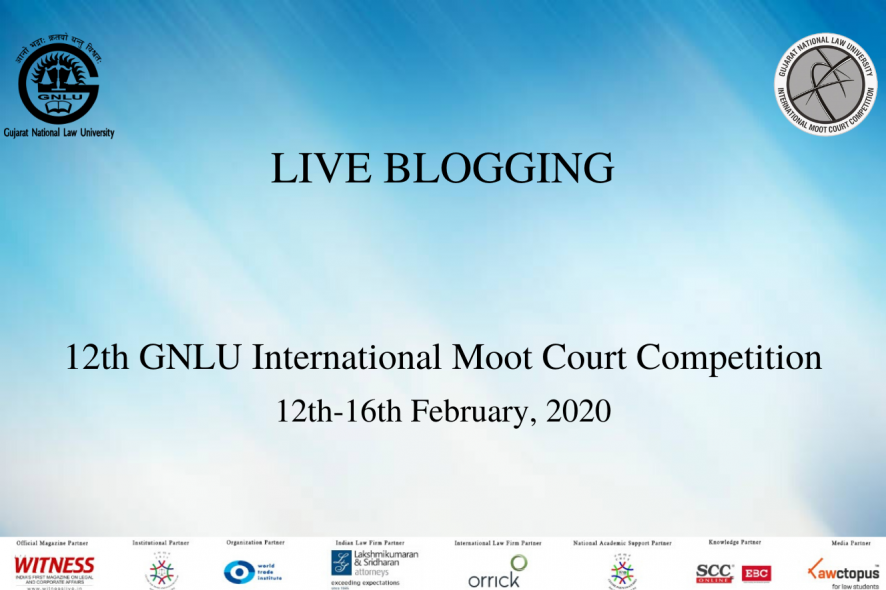The decade-old moot is back for its twelfth edition! GIMC has always been known for its high-quality participation as well as judging and this year, the moot is breaking all records. 52 teams have gathered from all around the world to battle for the prizes and to finally put all their preparation to the test. GIMC is the only Trade Law Moot in India that simulates a WTO dispute redressal mechanism and this has consistently attracted a number of bright legal minds.
The moot problem of this year seeks to stimulate intriguing discussion on the General Agreement on Tariffs and Trade (GATT) and the General Agreement on Trade in Services (GATS). Up for grabs are the prizes of Winning Team, Runners-Up, Best Orator (Finals), Best Orator (Prelims), Best Researcher, Best Written Submissions, Second Best Orator (Prelims), Second Best Researcher, and Second Best Written Submissions.
The entire moot is conducted by the students of GNLU, with an Organising Committee of more than 100 members, along with assistance from their faculty Conveners and the support of the Director, Professor Dr. S. Shanthakumar. Additionally, Lakshmikumaran & Sridharan Attorneys, World Trade Institute, Orrick (International Law Firm Partner), Centre for Trade and Investment Law- Indian Institute of Foreign Trade, Centre for WTO Studies, Lex Witness, Eastern Book Company, SCCOnline, and Lawctopus are the official partners of GNLU in organizing this event.
The moot is soon to begin and we are here to keep you updated on exactly what is going on! You can also follow us on Twitter, Instagram and Facebook for more insights.
Registration and Inauguration Ceremony
16:45 With the excitement coming in, the registration has started. The participants are being given their respective folders, T-shirts and of course the delicious cupcakes!
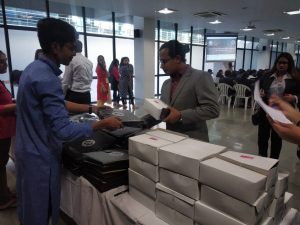
17:00 The crowd is buzzing with excitement as they go through their folders, planning their next move for the upcoming rounds starting tomorrow!
17:05 Meanwhile, let’s take a look at the prizes up for grabs! 4 days of intense competition for these trophies, totally worth it.
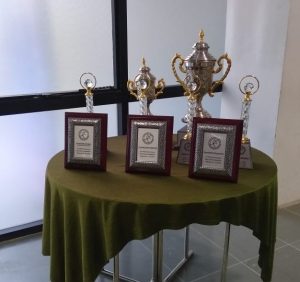
17:15 The dazzling core organizational committee, catching a breather and a laugh before the frenzied activity resumes and months of hard work fructify over the next four days.
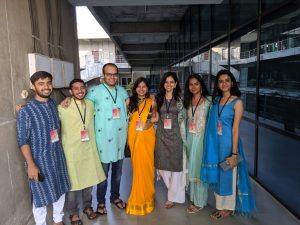
17:30 The inauguration ceremony is underway! We have Organizing Committee Members Soham Munshi and Akanksha Singh who introduce the members on the dais- Prof. Dr. S. Shanthakumar, Director, GNLU; Dr. Jagadeesh Chandra T.G., Registrar, GNLU; Dr. Mamata Biswal, Dean of Academic Affairs, GNLU; Dr. Girish R., Faculty Convener, GIMC 2020 Organising Committee.
17:35 Prof. Dr. S. Shanthakumar, Director, GNLU begins his inaugural address by welcoming all participants to GNLU. He also notices that the problem requires participants to develop an in-depth understanding of international trade law. He also notes that participants will have access to well-learned panelists, who will further guide the participants to improve their understanding of the law. He further mentions that this problem has been perceived to be the best problem of the GIMC so far!
17:40 The Dean of Academic Affairs, Dr. Mamata Biswal addresses the gathering next. She describes this inauguration as a momentous occasion. She expresses gratitude to the Director for his constant support in promoting the organization of various programs at the University. She also appreciates the sheer sense of determination on part of the Organizing Committee which has helped in reducing costs and promoting the growth of the competition. She goes on to describe the art of mooting as not an achievement, but an opportunity to hone skills. She also discusses the importance of moot court competitions across the world. Although mooting differs from real-life court situations, it teaches students how to apply the law. It develops analytical, research, writing and speaking skills, which are merits taking precedence over winning the trophy. She especially emphasizes the evidence of moot court competition in the academic career of a law student for law firms and legal counsels, as it shows strong legal acumen and the ability to form arguments. She draws to a close-by attributing the success of the competition to our Faculty Convenor and wishes the participants good luck.
17:45 Next, the Faculty Convenor of the Moot Court Committee, Dr. Girish R addresses the august gathering. He recounts the journey of GIMC, from one edition to the next, reviewing how GIMC contributed to the study of trade law. He describes how GIMC grew from an ordinary international law competition to one specializing in trade law. He further assures the participants that it is his responsibility to see that the conduct of the competition is fair, with brilliantly qualified judges from the prelims to the final rounds. Next, the Faculty Convener of GIMC, Dr. Girish R. announces the prizes of the competition. This surely catches the attention of the participants! He also welcomes participants to intensify their collaboration with GNLU through programs and research projects. He draws to a close by asking participants to enjoy their time in GNLU as well as the facilities of the college.
The list of prizes can be accessed here.
17:55 Abhijit Narayan, Foreign Counsel and Head of India desk and Middle East desk, Orrick, Herrington and Sutcliffe LLP, skype in and wishes all the participants the best of luck. He further expresses his interest to connect with the participants on LinkedIn and address any of their queries.
18:00 Mr. Devarsh Kotak, Logistics and PR Coordinator of GIMC, conducts the orientation on the rules of the competition.
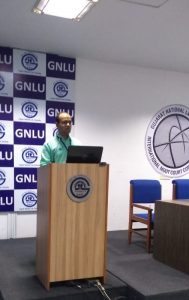
18:05 Ms. Akanksha Singh, Chief Scorer, now conducts the orientation on the scoring pattern and procedure.
18:10 The inaugural ceremony now comes to an end. The researchers are requested to proceed for the researchers’ test scheduled at 18:30.
18:30 The researchers’ test is now underway! It will decide the best and the second-best researcher in GIMC.
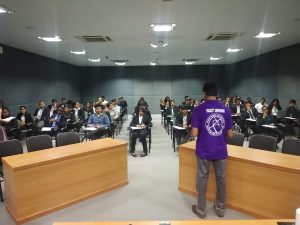
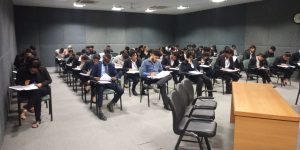
Day 2 ~ Preliminary Rounds I
9:00 The much-awaited first day of GIMC 2020 is here! A new day with the sun shining bright has set the perfect pace to encounter some exceptional quality of mooting!
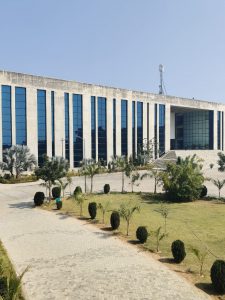
9:30 Its Prep time! With the preliminary rounds about to start, the teams have collected their thoughts, systemized their arguments and discussed their strategies. Its officially on, with the preparation on a full swing the teams look more than ready to demonstrate their mooting skills.

10:30 At last, the preliminary rounds we all have looked forward to, have begun! The teams with their high spirits are presenting their arguments which they have relentlessly worked on for a long period of time, in front of our esteemed judges. It is the perfect opportunity to check out their knowledge and grip on the law.
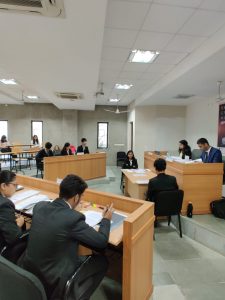
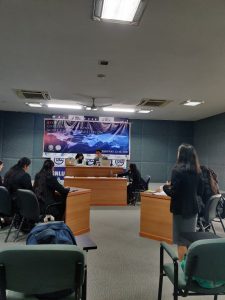
15:00 With the lunch all done for the participants, the preliminary rounds are back on track. All teams look well prepared and confident in their approach for their rounds and with that spirit, the rounds have been resumed and the mooting continues!
20:00 The first day of GIMC 2020 is nearing an end, the participants are now making their way to dinner. It indeed was a day filled with the demonstration of excellent mooting skills and impressive rounds!
Day 3 ~ Preliminary Rounds II
10:00 This WTO Panel is now in session! It is a new day and the one on one battles between teams continue. Day 2 of preliminary rounds is just as heated as the first day. When there is so much preparation on both sides, that of the team and the judges, such high-quality mooting is to be expected!
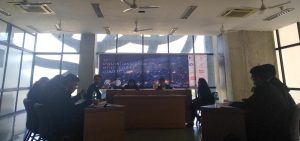
11:00 Rounds proceed with pointed questions, quick answers and a deft dispensation of authority and logic.
14:00 Lunch is almost done for the participants, and the preliminary rounds will soon continue. By now, the judges are well aware of many arguments that can be created from the problem but the participants continue to surprise the judges with newer and fresher outlooks on the same laws. It is indeed a pleasure to watch.
19:00 The preliminary rounds of GIMC 2020 have officially concluded. These rounds were surely grueling! The participants now anxiously wait for the results of the preliminary rounds.
19:30 The Teams have now gathered at the orientation hall for the Participation Certificate Distribution Ceremony.
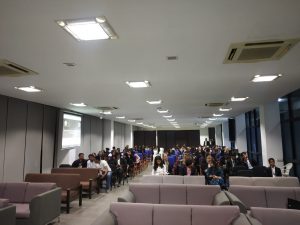
19:35 Ms. Corrine Karlagnis from the World Trade Institute, Bern now makes a presentation on the background and core activities of the WTI. She discusses various programs, research and academic activities undertaken by the WTI and how it is contributing to the field of Trade Law. She further talks about the academic and positive environment in the World Trade Institute and how one can redress any of their queries given the approachable faculties and mentorship program. For detailed information, click here.
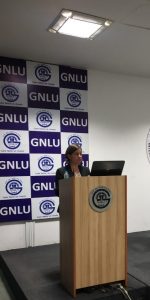
19:55 A moot is nothing without its participants, and to honor our brilliant participants in this edition, our Director Sir and Registrar Sir along with Prof. Dharmendra Kumar Mishra from Banaras Hindu University are now handing out the participation certificates.
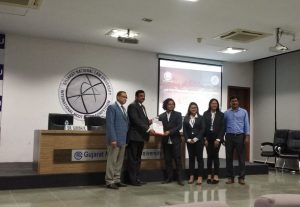
20:20 Ms. Stuti Toshi, Senior Research Fellow at the Centre for WTO Studies and one of the judges of the preliminary rounds makes a presentation on the background of the Centre. She goes on to talk about the joint academy organized by the Centre in collaboration with the World Trade Institute and how it introduces a person to the vast field of International Trade Law.
20:25 Mr. Rohan Merchant, Student Convenor of the GNLU Moot Court Committee proceeds to make a presentation on the LLM program offered by the European Public Law Organisation (ELPO), one of the sponsors of GIMC 2020. He further discusses the LLM program offered and how it is based on three major pillars of Trade, Competition and Investment. More details on their LLM program can be accessed by clicking here.
21:25 The Organizing Committee is fully prepared for announcing the breaks! The results will be here any minute.
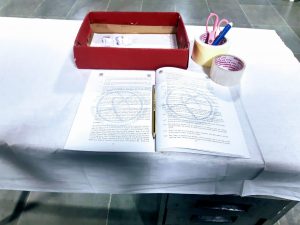
21:30 The most awaited moment is here! The teams who have qualified for quarters have been announced. The ones who made it to the quarters (in alphabetical order) are:
Institute of Law, Nirma University
National Law Institute University, Bhopal
National Law School of India University, Bangalore
National Law University, Jodhpur
School of Law, University of Petroleum and Energy Studies, Dehradun
Strathmore University
Symbiosis Law School, Noida
University of Southampton
We congratulate the qualifying teams! Tomorrow shall be another crucial day, with the Quarters and Semi-Final rounds. Stay tuned for updates!
Day 4 ~ Quarter Finals
9:30 The courtrooms are ready, the teams are prepared. We start the third day of GIMC 2020 eagerly awaiting the Quarter Final Rounds to begin!
9:45 The judges are seated, the teams look confident and with just the right amount of enthusiasm and excitement, we are ready to begin the first round of #GIMC2020 Quarter Finals! We wish all the teams the best of luck and may the best team move forward!
11:00 With the first round nearing an end, we can’t wait to see what the second round as in the store for us and see what a tough competition they give! Each step, each decision they take today, decides whether or not they make it to the Semi-Finals.
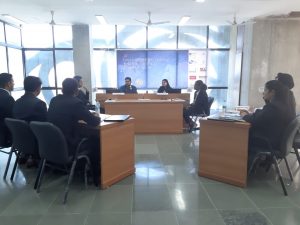
12:30 The teams keep surprising us with their amazing mooting skills, solid legal knowledge, and well-structured arguments. It is going to be a tough call to see who’ll move forward but a decision we all eagerly await!
13:20 The second set of quarterfinal rounds are almost over. One courtroom has finished hearing its arguments for the day. That was an extraordinary display of advocacy skills we saw, and now, the nerve-wracking wait for the results has begun! Good luck to all the teams!
14:20 The Quarter Final Rounds have come to an end and all the teams have left us baffled! The decision was a tough one but its finally here, the teams who would be making it forward to the Semi-Final Rounds ( in alphabetical order) are:
National Law School of India University, Bangalore
School of Law, University of Petroleum and Energy Studies, Dehradun
Symbiosis Law School, Noida
University of Southampton
~Semi Final Rounds
14:45 The preparation for upcoming rounds is on with full power. The Court Room is all ready to host the first round of #GIMC2020 Semi-Finals! If you are around the campus, do come to watch the rounds!
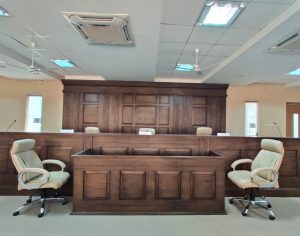
15:00 The teams are in the courtroom now. Last-minute prep continues as they complete the pre-round formalities. Teams are discussing how to communicate with each other during the course of the rounds. The panelists have arrived and are now seated, ready to begin the rounds. Our today’s esteemed panelists are:
Ms. Pallavi Bajaj, Partner, TCube Consulting LLP
Mr. Adarsh Ramanujan, Independent Legal Practitioner
Ms. Shailja Singh, Legal Consultant, Centre for WTO Studies
15:05 The first speaker for the Complainant begins her submissions by laying down her structure. She seems confident, and the judges listen intently.
15:06 Mr. Adarsh asks for a brief of the facts from Speaker 1 and she explains the same in a calm and composed way.
15:10 The speaker seems confident in what she is stating and upon being asked a question by the panelist, she seems to understand the query and calmly answers the question. Mr. Adarsh seeks a further clarification however the Speaker elucidates the same by referring the panelists to her compendium.
15:12 Another clarification sought from Mr. Adarsh regarding a minor fact. The speaker replies by referring the Panelists to the moot proposition. However, the Panel seems dissatisfied. The Speaker now moves on to her second submission.
15:17 The panelist listen carefully to the arguments being provided to them by the Speaker. The panelist continues questioning the speaker, using a hypothetical situation to explain his question. The speaker states that she is unaware of any such contention.
15:22 The Speaker continues by gathering her calm and ends confidently making way for her co-agent to deal with the remaining issues.
15:24 Speaker 2 begins making his submissions. He is confident and moves smoothly without deviating from his arguments. The panelist stops the speaker to ask a query to which he answers confidently and moves forward with his arguments without getting fazed.
15:26 As there are no questions from the Panel, the Speaker now moves to his second limb of arguments.
15:28 The panelist asks a question which seems the speaker doesn’t seem to understand completely however with the use of the quick thinking he manages to answers the panel to their satisfaction.
15:30 The panel asks the Speaker to go back to the first issue and answer a couple of questions. The Speaker backs his answer with authorities and applies the law laid down to the facts of the case.
15:33 The panelist doesn’t seem too satisfied with the speaker’s answer so he explains the question further trying to look for an answer. The speaker tries to answer the question duly however the panelist still doesn’t look satisfied. The panelist decides to move on and ask the speaker further questions.
15:35 The speaker uses some provisions, and the usage is questioned by the panel. However, the speaker disagrees with the panel and uses an authority to answer the question. However, the panel does not seem convinced. The speaker continues persuading the panel about his arguments. He directs the panel to his written submissions as he guides them. The panel seems largely interested in this argument. Speaker 2 answers the question and concludes by thanking the panelists.
15:36 The Respondent now starts by laying down a proper map to their arguments and how they intend to bifurcate their time. Once they have laid down the road map, speaker 1 begins with her arguments in a calm and composed way.
15:40 The panelist places his first question before the speaker. The speaker seems to have already anticipated this argument and gives answers which she seems to be well prepared for.
15:42 The panelist further seeks clarification which doesn’t seem to faze the speaker at all as she calmly assists the panelist with the proper legal backing to her arguments.
15:43 Facts are the key! The speaker states the facts which help her argue his contentions. The speaker seems to have a blend of both law and fact as she answers confidently. The wave of questions however continues.
15:44 The speaker has a case ready for each clarification the Panel is raising, that is some level of preparation and research. She is currently raising new and innovative points with regard to the interpretation.
15:45 The Speaker guides the Panel to her compendium to clarify her arguments. She has been using the compendium frequently. Truly a lifesaver! The Panel is satisfied and asks the Speaker to proceed with her arguments. She continues in a confident and calm tone.
15:50 The Panel poses a clarification on the case-law cited by the Speaker. The Speaker tries to dodge the question by stating that the same will be answered at a later stage.
15:52 The Speaker is well versed with the law. She extensively cites case laws and authorities to provide legal backing to her submissions.
15:54 The time has elapsed for the Speaker. However, the Panel goes on to question the Speaker.The speaker seems to take a second or two to collect her thoughts and then continues to answer the question by stating the facts in her favor.
15:56 The Speaker concludes by requesting the Bench to accept the submissions made by her.
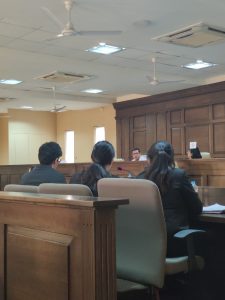
15:57 Speaker 2 starts by guiding the Panel to her written submission. She lays down a comprehensive structure of her arguments.
16:00 The Panel again poses a question on similar lines. The Speaker is well versed and answers confidently.
16:02 The panelist gives a hypothetical situation to the speaker and asks her whether the contentions being laid done by her would still apply in that situation. To this, the speaker confidently answers affirmatively and supports her arguments by trying to back it with law. The panelist isn’t completely on board with the answer and further question her on the same to which she calmly replies demonstrating her calm and confident demeanor and good hold on the law.
16:05 The Speaker continues with her second submission by guiding the attention of the Panelists to her written submissions.
16:07 The Speaker now moves on to her last limb of the submissions. The Panelists seem satisfied with her arguments and listen intently.
16:08 The Panel poses a question on the interpretation of the case-law laid down by the Speaker. She answers by stating the facts from the Moot Problem.
16:11 The panelist tries to clearly understand what the speaker’s exact contentions mean. She affirmatively answers and summarises the arguments raised to help the panel understand the argument being made.
16:12 The Speaker now moves on the last limb of her submission. However, the Panelists ask her to move back to the previous argument and answer a certain set of questions which she able to answer correctly.
16:14 With the time running ahead, the speaker picks up her pace and finally moves on to her last argument after answering all the queries the panelists have.
16:16 The speaker skillfully manages to finish her arguments in time. Just as she finishes her arguments the panelist poses a question to which she very confidently answers.
16:20 The speaker from the respondent side finishes her arguments by being the panelists’ attention to the prayer. The Rebuttals rounds begin and the Complainant rebuts the claims made by the respondents on three specific points. The Panel interferes and seeks a yes/no answer on a question from the Claimants.
16:22 The Speaker from Respondent confidently answers by guiding the Panel to the facts of the case. She further clarifies the interpretation of the moot problem and concludes by referring the Panel to her written submissions.
16:24 Once the sur-rebuttals are made the panelist poses the same question posed earlier to the complainants. The Respondents answer the question only to be further questioned by the panelist again to which she calmly replies.
16:26 With that the first round for the Semi-Finals has come to an end and the participants exit the room for the panel to be able to discuss and mark them.
16:43 The panelist give general feedback to all and thank both the teams for presenting their arguments. With that both the teams are dismissed and the preparation for the next round begins!
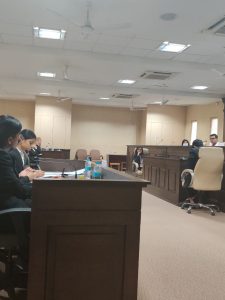
17:03 The second round has started and the first speaker from Complainant started by laying down the structure of her arguments and every issue they would be dealing with.
17:05 The speaker continues speaking very confidently in a calm and composed voice and the judges seem to buy her arguments.
17:07 After listening intently to the arguments being presented the panelist posses his first question to which the speaker answers confidently using her legal knowledge. The panelist seems to be on board with her arguments.
17:11 The panel listens intently and upon raising a question, the speaker moves on to the next issue after seeking due permission to move ahead. The panel then posses another but upon a quick answer from the speaker, the panelist stops her in the middle of answering and asks her to continue with her argument. Looks like the panelists are on board with the arguments the speaker presents.
17:13 The Panel seeks clarification on the legal proposition applied by the Speaker. She replies by stating that its interpretation lies in her favor.
17:15 The panelist further questions the speaker which she intently listens to and then calmly answer by supporting her arguments with the case facts provided in the Moot Problem. Upon further questioning, the speaker agrees that further research might be needed but still manages to give the panelist a satisfactory answer.
17:16 The Panelists seem to be interested in the application of law as stated by the Speaker and listen intently.
17:19 The panelist further questions the speaker, it seemed as though the speaker had anticipated the question and goes on to answer confidently. The panelist tries to check her legal knowledge by asking her a technical question to which she replies correctly, satisfying the panelists.
17:22 The panelist keep the questioning going, the speaker fumbles a little but quickly regains her composure and answers the question raised before finishing her arguments.
17:24 The second speaker starts with her arguments and carefully divides her arguments to be able to cover all the issues in a timely manner. The speaker speaks calmly, clearly and confidently as she continues presenting her arguments. The panelists listen intently.
17:26 The panelist pose the same question they had asked the first speaker earlier and ask the speaker if her stand would change in the given circumstance however the speaker stays put on the answer her co-agent had given earlier.
17:27 The Panel seeks clarification on the understanding of the facts in question.
17:29 The panelist finds it difficult to understand the logical correlation between the arguments, and the debate on facts continues. The panelist keeps posing hypothetical situations and attempts to understand the crux of the arguments raised by the claimant.She further moves forward to her second argument.
17:34 The speaker argues against the probable defense the respondent would take, the panelist question them on this point to which the speaker answers which seems to have been accepted by the panelist.
17:37 The Speaker is calm and confident in answering each and every question raised by the Panel. She concludes by stating her prayer before the Panel. However, she is interfered with by the Panelist as they pose a logical argument before her. She replies instantly by using the facts in her favor.
17:38 Again, a hypothetical question is put forth by the Panel and the Speaker is asked to apply the law she stated in the particular case.
17:40 Speaker 1 from the Respondent starts by briefing the Panel on the issues in question. The panel asks the speaker to give a brief of the case facts and what they consider are the important facts of the case.
17:42 The Respondent continues on with her speech, now linking the law stated by her with the facts.
17:44 The Panel inquires about the legal backing used by the Speaker. The speaker replies calmly which seem to satisfy the Panelists.
17:46 The speaker keeping in mind the time limit makes a clever decision knowing that the argument isn’t being bought by the panelist, she quickly seeks permission to move forward with her next issue.
17:47 The Panel poses a question on the application of the law. The Speaker guides the Panel to her written submissions to substantiate her argument with legal backing. The panel points out that its a hypertechnical argument. The speaker seems to know when to move ahead and leave an argument, she controls the direction of the argument than letting the panelist take her off track.
17:50 The Panel poses a question on the application of the law. The Speaker guides the Panel to her written submissions to substantiate her argument with legal backing. She further mentions that even if the Panel is not satisfied with the first argument, an alternative argument will be presented before the Panel. The Speaker is well versed with the facts and the applicable laws on the case and proceeds to make submissions smoothly.
17:57 The Panel shows a keen interest in the submissions of the Speaker and clarifies a few of the legal propositions. As time runs out, the Panel asks the Speaker to summarise her arguments and conclude.
17:59 Speaker 2 from the Respondent begins with her arguments without laying a structure since the same was done by Speaker 1.
18:01 The Panel asks the Speaker to contradict the Claimants argument. She does so after taking a momentary pause.
18:05 The Speaker is well versed with the facts and answers all questions by using the facts.
18:10 The Respondent speaker cleverly plays with the facts in her favor. The panelist stops her to ask a question on which she fumbles as she tries to think of an answer but quickly comes up with an answer before she is stopped by the panelist when they pose another question to which she satisfactorily answers and moves ahead with her arguments. The panelist stop to gain clarity whether the speaker had conceded to the question asked before, to which she replies negatively and moves on with her arguments.
18:12 The speaker now moves on to her last submission since there no questions are being asked by the panelists.
18:15 The team is fully prepared with alternative arguments. One fails, other crops out!
18:19 The Panel asks the Speaker to conclude since the time has run out.
18:21 The Respondent speaker finishes her arguments and the complainant team is ready with their rebuttals!
18:24 The complainants lay down their rebuttals in a structured manner and address how exactly the Respondents failed to cover those issues in their submissions. the judges listen intently before putting a yes/no question up which the complainants answer without a second thought. The respondents are attempting to quickly note down all the questions raised, all of which must be answered by them in their two minutes.
18:24 The respondents begin answering the rebuttals, the speaker for the respondents answers the questions in an extremely structured manner and refers to the facts of the case. The panelist put the same yes/no question which the respondents answer confidently, further clarification is sorted by the panelist which is duly answered by the respondents.
18:27 The second round for GIMC 2020 Semi-Finals has come to an end. The teams have moved out while the judges discuss their performance.
18:40 The judges thank both the teams and appreciates their hard work. The judges are impressed with both their deliveries and clarity in thought. The panelists end by wishing both the team good luck! The rounds have ended and all the teams have time and again amazed us with their skills now the wait for the results begin!
Day 5 ~ Finals
9:55 The most awaited day of #GIMC2020 is finally here. We have been looking forward today for a long time now and finally, the nail-biting suspense has come to an end, the results are out! The two teams who are going to qualify and go against each other are :
Symbiosis Law School, Noida
University of Southampton
10:10 The last of the competition has started. The Court Room is prepared to host another fabulous round of mooting. The teams are seated, last moment and strategies are being discussed as we eagerly await for our honorable panelists to make their way to the courtroom.
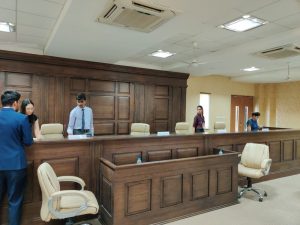
10:25 The wait has ended, our esteemed members of the panelist have made their way into the courtroom. Our esteemed members of the panelist for the final rounds for today (from left to right) are:
Ms. Anuradha R V (Partner, Clarus Law Associates),
Dr. James Nedumpara (Professor & Head, Centre for Trade and Investment Law, Indian Institute of Foreign Trade),
Mr. V. Lakshmikumaran (Managing Partner, Lakshmikumaran & Sridharan),
Dr. Werner Zdouc (Director, WTO Appellate Body Secretariat).
Mr. Shashank Kumar (Dispute Settlement Lawyer, WTO)
10:26 The courtroom is set and the audience is gathering. The participants are also seated now. Our Panelists arrive and begin to settle down. Pretty soon, the final rounds will be underway!
10:28 This WTO Panel is now in session! These words mark the start of the Final rounds for GIMC 2020. The Panelist, Mr. V. Lakshikumaran calls on the first speaker for the complainant, Speaker 1 to begin her submissions.
10:29 Speaker 1 seems well prepared with the facts, and explains the crux of the facts to the panel, with confidence. The Speaker begins by explaining the CPC classification and explaining the difference between telecom services and database services.
10:30 She guides the Panel to paragraph 14 of the Moot Problem in order to elucidate her point.
10:31 The speaker is confident and proceeds with her arguments since the Panel has no preliminary questions.
10:32 The Speaker mentions that panels have taken a common sense, realistic and teleological approach in the past to classifying services. Mr. James asks by what stretch of the imagination the new category of services could be included in the schedule.
10:35 The Speaker replies to all the queries posed by the Panel calmly and confidently and proceeds with her submissions.
10:36 The Speaker relies on section 3 to 5 of the Social Media Regulation Act to create a foundation of her argument. The complainant argues that the mode of supply engaged in mode 1.
10:38 The Complainant refers to Mexico Telecom, to argue that it is analogous to the present situation.
10:40 Mr. Werner asks the complainant for an alternative argument. The speaker uses her answer to round up and complete her first submission
10:41 The complainant argues that the respondent has breached its national treatment obligation under article 17 of the GATS because of preferential treatment to domestic suppliers. Mr. Shahshank asks to what extent the social credit plan can be a measure challengeable? To which the speaker skillfully answers to the satisfaction of the panelist.
10:43 Ms. Anuradha poses a question to the speaker whether if the speaker is only challenging the source code sharing obligation as a violation of national treatment, but is not challenging the data localization requirement. On the speaker’s stipulations affirmation, the panelist probes further – since any kind of localization is some kind of residency requirement, isn’t that more tantamount to a national treatment violation? She also inquires why the speaker claims there is a quota requirement because technically there is no such quota requirement, and the law does not prescribe a specific number?
10:45 The speaker after answering all the questions posed by Ms. Anuradha moves forward with her arguments only to be stopped by Mr. Werner who poses a question on how the local service provider is different than a foreign service provider.
10:48 The speaker argues that Argentina’s Financial Services can be taken into account in this case. Even on the facts, the companies are similar and goes on to elucidate why there is substantial similarity so as to constitute services.
10:51 Ms. Anuradha guides the speaker back to the question of classification of services and says that possing a network is an important precondition, and its a technological advancement. She claims that possessing a network will consist of both hardware and software and therefore should come under a different classification in UN CPC. and why would they want to classify the same as telecommunication service?
10:53 The speaker successfully answers the questions as the time runs out; the speaker quickly concludes her arguments.
10:56 Dr. Werner inquires whether resource code sharing would be dealt with under Article 14? Mr. Werner further asks how does the source code transmission to the government would affect the service supply?
the speaker submits that it does affect the service supplied because it is violative of the privacy policy of the complainant, thus amounting to discrimination, and it affects the nature of the service supplied because the govt is asking for it so it can monitor social media usage online.
10:58 The second speaker started with her arguments in a calm and composed manner. She submits her arguments to the panelist and then provides an alternative argument based on the case of EC Asbestos which gives importance to the principle of end-user. The speaker sites the case of EC Bananas in order to establish that violation of Article 34 has taken place. She anticipates the respondent’s arguments on the aim of the legislation and contradicts the same.
11:00 The speaker addresses the first criteria. The products must be like products – in this regard she puts forward two arguments. First, in India Autos the panel said that if the sole distinction is the country of origin, the products are like products. The alternative argument is that likeness can be established with the general criteria developed by the Appellate Body in EC Asbestos. In relation to this, she relies on the grounds of end-use, and consumer tastes and habits. The speaker addresses the second criteria which are – the measure in question should affect the use of the products. The speaker argues two grounds on the issue of affecting – that the use of the products is affected because of a disincentive for the imported technology equipment in favor of domestic equipment. And that the measure affects the purchase of the equipment because imported technology is less likely to be purchased if companies will not receive any benefit from it. For the third criteria which are, the treatment less favorable must be accorded to imported products than domestic ones. The speaker relies on EC Bananas, which gave this a broad interpretation. The speaker submits that a disproportionate level of protection was given to domestic products. this modifies the conditions of competition as per the authority of US FSC.
She also argues that the aim of the legislation is irrelevant when considering less favorable treatment and the purpose, cannot remove the discrimination that has occurred.
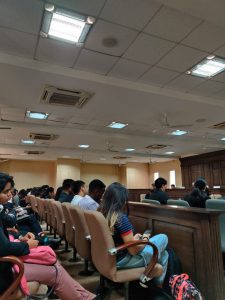
11:07 The speaker also rebuts the respondent’s contention that government procurement has occurred on two grounds – first, according to Canada renewable energy, procurement is similar to purchasing. the govt has not procured but acquired the data through legislative means. there has been no payment for the data procured. second, the speaker draws an analogy with Canada’s Renewable energy report, to establish that there is no link between the procurement and the product. With that, she contends that the WTO laws haven’t been duly followed.
11:11 The Speaker 1 from Respondent begins by laying down a brief structure of her arguments and how the issues will be dealt with by her and her co-counsel. The first speaker for the respondent claims that there has been a mischaracterization of the services because they should actually fall under the sub-sector of computer and related services. This exchange of data and the message transmission is one of the functions of Be Connected. for classification, all the functions must be taken into consideration in the digital economy
11:12 The Government has not differentiated and has implemented measures equally. She claims that the services offered by the social media operator should fall under computer and related services. She guides the attention of the Panel to para 14 of the moot problem and claims that the said service offered will not fall under telecommunication services since it also involves the exchange of photographs and videos and feelings.
11:15 The speaker states that for classification, not one but all functions of Be connected have to be considered. To substantiate her argument, she guides the attention of the Panel to her compendium. Ms. Anuradha states that classification under the stated article is much wider and not restrictive as claimed. It includes data exchange in all forms. Mr. James proposes that for the purpose of classification, there could be a better category instead of a computer and related services. The speaker acknowledges that the lists were originally formed at the Uruguay Round of Negotiations, but social media services were not available then. They are from this century. the functions of service supplied have to be considered in their whole sense. Be Connected has several functions.
11:20 Mr. Shashank poses a question on how can it be differentiated whether messaging and sharing of feeling as it can be tangibly measured to which the speaker submits that for the classification of services, one must keep in mind other functions as well. She argues that para 14 of the moot problem says that individuals could become members, build profiles and accounts, share content and search for other users and become their buddies, and can build social relationships. The end-use must be established for the purposes of classification. the end-user is derived from all the functions. Mr. Shashank said that all of those things at the end of the day are geared towards messaging. How can all those functions like creating an account be disengaged from the function of messaging? The speaker responds with the submission that a distinction should be made between posting and sending a message.
11:25 The Speaker is well versed with the moot problem and keeps on guiding the Panel to it for answering any of the queries. Ms. Anuradha seeks clarification on the proposition of the commercial presence of the supplier. The Speaker responds by referring the Panel again to the moot problem. The Speaker is constantly referring to different authorities, namely the US Gambling Case and the case of Various Measure on Beef (Korea) to substantiate her argument that in order to maintain public order, any measure can be adopted by the State.
11:30 The speaker makes use of the GATS article by pointing towards its footnote stating that the law can be invoked even if it isn’t clearly stated if the public policy of the nation is in question and uses the test of necessity.
11:33 Ms. Anuradha questions the use of the test of necessity to which the speaker confidently answers almost as if she had expected this question to come her way. Ms. Anuradha states that the necessity test requires weighing and balancing, so in this case, was this the only option available to the respondent. In a modern developed society, there are other mechanisms available for a security. The speaker replies that there is an imminent threat to their security, and with regard to the trade impact of the measure, the respondent’s main objective is their own security. The social media regulation act was only passed after consultation with relevant stakeholders, and other small foreign companies have agreed to comply with it. The respondent also argues that another country cannot question the security concerns of another State.
11:35 No country can question the laid down law of the country concerning the National security of the country to which Mr. Werner asks whether the speaker means to say that no one has the jurisdiction to question if the National Security of a nation is in question speaker replies saying that she isn’t contending so, to further substantiate her answer the speaker guides the panel members to the preamble of GATS with that the speaker concludes her arguments.
11:38 Speaker 2 from the Respondent starts by briefing the Panel about her structure of arguments. Dr. Werner interjects and seeks a clarification of the application of Article 14 (c) (2). The Speaker responds by explaining the concept of Source Code and how it operates. She substantiates her arguments by detailing the provisions of SMRA.
11:43 The panelist bombard the speaker with questions, Mr. Shashank asks the speaker if the social media regulation is found to be inconsistent, how she would sustain her submissions. Mr. Werner asks the respondent if she is not now conflating article 14(a) with 14(c). The Speaker skillfully assists the panel with all the questions they have asked.
11:45 The respondent argues that with respect to the weighing and balancing test, it is necessary to look at it holistically. The speaker says that the WTO Agreement does not contemplate a burden for the respondent to look at the entire universe of alternatives. It is merely a weighing of the measure at hand.
11:50 Mr. Lakshmikumaran ask the speaker a fundamental question which is to explain what exactly a source code is, the speaker tries explaining it but Mr. Lakshmikumaran interjects and further builds on his question trying to see the basic understanding of the speaker but not satisfied with the speaker’s answers states that the speaker is repeating herself and if the question can’t be answered she could kindly move ahead with her arguments.
11:55 Speaker proceeds with her submissions and contends that under Article 3 (8)(a), the respondents are permitted to do favorable treatment in their nation.
12:00 Speaker proceeds ahead to state that they aren’t stopping the company from coming in their country but simply applying restrictions for the purpose of National Security. Speaker relies upon the Canada Renewable Energy and states that the government is using the data for themselves on which she is questioned by Ms. Anuradha, however, the speaker guides her back to Canada Renewable Source report and tries to answer her question.
12:04 Mr. Lakshmikumaran appreciates the speaker for her heroic efforts of trying to skillfully save her arguments and further asks if she was attempting to develop an argument that there was an acquisition in this case which was tantamount to a purchase? The speaker fumbles and states that data is a commodity just like oil and electricity and alluded to a fact in the compromise branding data as the new oil. Mr. Shashank asks what is being procured for the purpose of 3(8)(a) which the speaker confidently answers.
12:10 The speaker finishes her arguments and the rebuttals begin!
12:12 The complainant starts their rebuttals and the panelist asks whether they would question a provision of constitution too which is affecting the current situation to which the complainant has to take a back seat as they need further research to be able to answer that. Mr. Lakshmikumaran states,” Good, you are a trade lawyer, not a constitutional law expert!”
12:15 Mr. Lakshmikumaran asks what is more important the data or the source code, the speaker replies it depends as both are equally important.
12:25 The respondent starts off with their sur-rebuttals and Ms. Anuradha puts up the first question stating that they are asking source code only from foreign service providers to which she states that the source codes are being asked from both foreign and domestic service providers. The speaker rebuts to the case of Russia transmit which was used by the complainant and states that they are applying the social credit plans and other measures to counter the issues raised by the complainants.
12:33 With that the Final rounds for GIMC 2020 has come to an end. What an intense and engaging round! Truly a magnificent round. With that, the wait for the results is on. Stay tuned to know the winners!
Valedictory Ceremony
All the teams have gathered in the Orientation Hall, waiting anxiously for the results.
13:10 The dias today is honoured with the presence of our finale Judges, Ms. Anuradha RV, Partner, Clarus Law Associates; Dr. James Nedumpara, Professor & Head, Centre for Trade and Investment Law, Indian Institute of Foreign Trade; Mr. V. Lakshmikumaran, Founder and Managing Partner, Lakshmikumaran and Sridharan Attorneys; Dr. Werner Zdouc, Director, WTO Appellate Body Secretariat and Mr. Shashank Kumar, Dispute Settlement Lawyer, World Trade Organsation along with Prof. Dr. S. Shanthakumar, Director, Gujarat National Law University.
13:11 Short video on journey of GIMC over the years.
13:18 Nr. V. Lakshmikumaran now addresses the gathering with an insight into the importance of trade law and mooting. He commends the performance of the participants since it involved a lot of research; given the complex moot problem.
13:20 Dr. Werner Zdouc now addresses the gathering. He talks about his travel experience to GNLU and how he had a wonderful time being here. He appreciates the efforts of the Organising Committee in making this moot a successful event. Lastly, he concludes by saying that all participating teams are winners since a lot of effort is required in the preparation of arguments.
13:24 Dr. James Nedumpara now shares a few words on his experience of being a judge of GIMC for the past 2-3 years. He further discusses how enriching working on a moot problem is! The way one articluates their research to present arguments and answer twisted questions. He concludes by giving an insinght into the working of Centre for Trade and Investment Law.
13:28 Ms. Anuradha RV shares how interesting judging GIMC is and the extensive research required by the participants to prepare their submission. She specifically mentions this year’s problem to be one of the best problems of GIMC. She concludes by appreciating the quality of presentation and articulation of trade laws by the participants.
13:32 Mr. Shashank addresses the gathering by thanking the Organisers for giving him a chance to draft the moot problem as well as to judge the finals. He further shares his insight on multilaterism and its future. He appreciates the area of law GIMC deals in and how it faciliates the area of international trade law.
13:34 The most awaited part of the ceremony is here. The winners are now being announced by Mr. Girish R.. The winners of the competition are Symbiosis Law School, Noida! The runners-up are University of Southampton.
13:44 Mr. Lakshmikumaran is delighted to inform that the internship opportunity will not only be provided to the Winners but also the Runners Up of the Competition!
Detailed Prize List is as follows:
Best Written Submission: Khatmandu University School of Law
Second Best Written Submission: Government Law College, Mumbai
Best Orator (Finals): Anishka Agarwal, Symbiosis Law School, Noida
Best Orator (Preliminary Rounds): Akshay Ashok, NLIU Bhopal
Second Best Orator (Preliminary Rounds): Riddhi RS, NLSIU Bangalore
Best Researcher: Daksha Khanna, GLC Mumbai
Second Best Researcher: Amay Bahri, National Law University Delhi
With this, the live blogging team of GIMC 2020 (Samira Mathias, Sharmistha Bindoria, Shivaang Maheshwari) signs off. See you next year!


